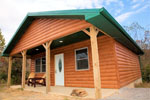WICKLIFFE MOUNDS STATE HISTORIC SITE
Open to the public since 1932, the museum exhibits the excavated features of two mounds with displays of Mississippian pottery, stone tools, artifacts showcasing their way of life and artwork, the archaeological history of the site and the architecture of mounds and houses. Visitors have a spectacular view of the bluff area on top of the Ceremonial Mound, the largest mound on the site. Special exhibits, hands-on displays, demonstrations and educational programs occur at various times throughout the year.
Scientific archaeological research through Murray State University has revealed important information about the Mississippian people here. This registered archaeological site 15BA4 is on the National Register of Historic Places, and a Kentucky Archaeological Landmark.
Please note Pets are prohibited on the archaeological site which encompasses the fenced in area around the mounds, buildings and trails service dogs allowed. Please call park office for questions regarding the pet policy.
Hours of Operation
OPEN 9 - 5
April 1 - November 15 Wednesday through Sunday
CLOSED Monday Tuesday
Winter - Open By appointment for groups.
Wickliffe Mounds is the site of a Native American village of the Mississippian mound building culture, located in Ballard County, Kentucky. This archaeological site was first occupied by the Mississippian Native Americans from A.D. 1100 to 1350. Around 900 years ago, Mississippian people moved to this bluff which overlooks the Mississippi River and built a village with earthen mounds, houses and buildings all surrounding a central plaza. The Native People at the Wickliffe site were typical of a vast culture that archaeologists call the Mississippians. Peaceful farmers, they grew corn and squash, hunted in the neighboring forests and fished the river they made pottery from shell-tempered clay with elaborate designs and decorations they participated in a vast trade network up and down the rivers they had stone, shell and bone tools they had a complex chiefdom level society they lived in permanent style houses made of wattle and daub and they built flat topped platform style mounds. For reasons yet unknown, the village was abandoned after the 1350s. Wickliffe Mounds was one of many Mississippian towns built along the river and was a residential and ceremonial center.
Early settlers to the region probably knew about the mounds at this site, but made little mention of it. The first formal notice occurred in 1888 when surveyor Robert Loughridge mapped the mounds for the Commonwealth of Kentucky. From 1895 to 1932, the site was owned by the Wisconsin Chair Company and was used for harvesting timber. In 1930, road crews building Hwy 51 cut through the southern edge of the prehistoric site and turned up pottery and other artifacts.
Because excavation destroys the part of the site being studied, modern archaeology justifies excavating only what will produce new information. Archaeology is a non-renewable resource. Until the most recent excavations are thoroughly studied, and new questions or techniques can be brought to the study of this site, or if mitigation projects become necessary, Wickliffe Mounds State Historic Site will continue to preserve the site and interpret the latest findings while keeping further disturbance of the site at a minimum.
In 2004, Murray State University transferred the Wickliffe Mounds archaeological site and its collections to the Commonwealth of Kentucky. Designated as the Wickliffe Mounds State Historic Site, the mounds are operated by the Kentucky Department of Parks. The site remains open to the public as a state historic site, a tourist attraction, an archaeological museum, and an educational resource.
Wickliffe Mounds is listed on the National Register of Historic Places, is designated as a Kentucky Archaeological Landmark and is an Interpretive Center on the Great River Road National Scenic Byway.
For more detailed information about the archaeology of the site, Dr. Kit Wesler, archaeology professor at Murray State University, has written an important book called, Excavations at Wickliffe Mounds, 2001 University of Alabama Press, and it is the most relevant and informative published material about Wickliffe Mounds to date.




